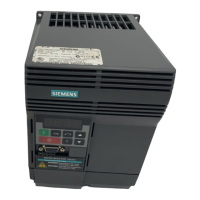5-1
5 BRAKING RESISTORS
5.1 DESCRIPTION BRAKING RESISTORS
The PM240-2 Power Modules cannot regenerate power into the line supply. For regenerative operation, e.g.
the braking of a rotating mass, a braking resistor must be connected to convert the resulting energy into heat.
A thermostatic switch monitors the braking resistor for over-temperature and issues a signal on an isolated
contact if the limit value is exceeded.
5.2 SAFETY INSTRUCTIONS
Risk of fire and device damage as a result of ground fault / short-circuit
The cables to the braking resistor must be routed so that a ground fault or short circuit can be ruled out. A
ground fault can result in fire.
• Comply with local installation regulations, which allow this fault to be ruled out.
• Protect the cables from mechanical damage.
• In addition, apply one of the following measures:
Using cables with double insulation.
Observe adequate clearances, e.g. through the use of spacers.
- Route the cables in separate cable ducts or pipes.
Risk of burns or damage resulting from high surface temperature of the braking resistor
The braking resistor can become very hot. You can be severely burnt when touching the surface.
Neighboring components can become damaged.
Mount the braking resistor so that it cannot be touched. If this is not possible, at the dangerous
locations, attach an appropriate warning note that is clearly visible and easy to understand.
To avoid temperature-related damage to adjacent components, follow these rules:
For PM240-2 Power Modules:
- Ensure a cooling clearance of 100 mm on all sides of the braking resistor
5.3 DIMENSION DRAWINGS
Braking resistors for PM240-2
Figure 10 Dimension drawing of braking resistor for PM240-2, frame sizes FSA / FSB

